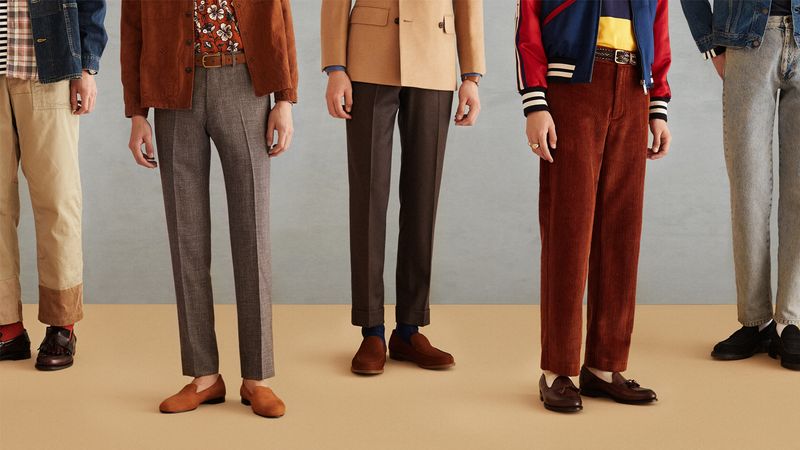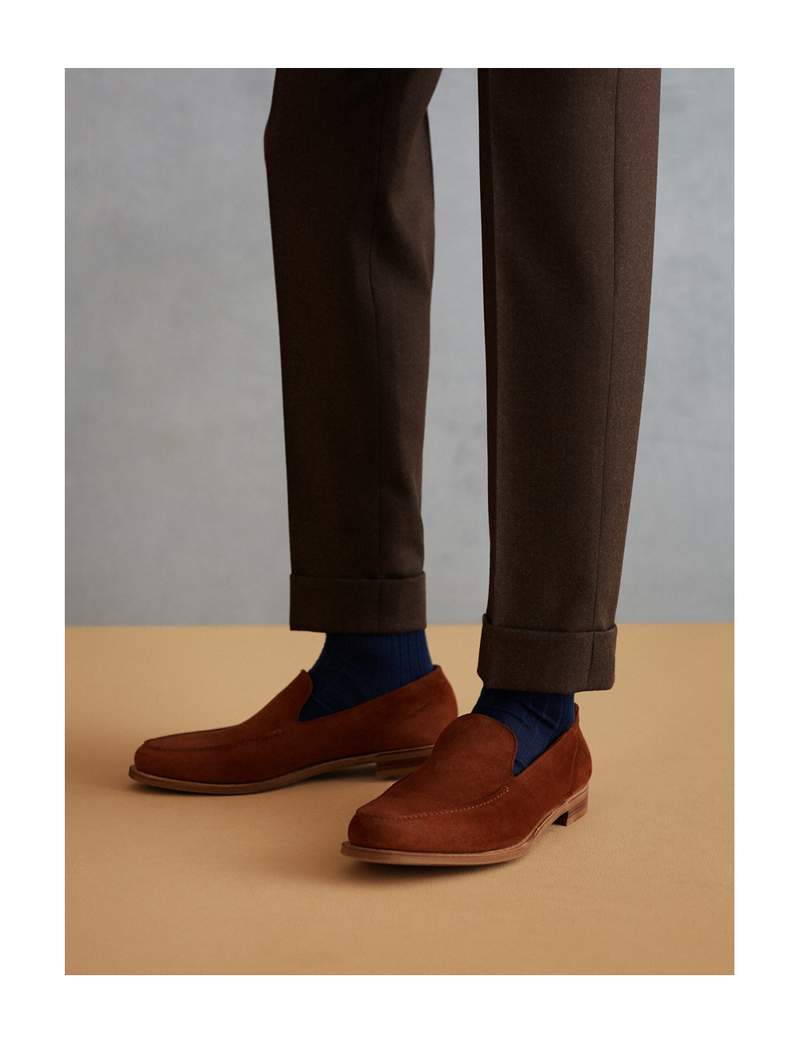THE JOURNAL

To loaf is to idle, and so loafers are idling shoes. Or, at least, they were. The rules of attire have evolved somewhat since the mid-20th century, when Bass Weejuns – a style of loafer inspired by a Norwegian fisherman’s shoe – first became popular on Ivy League campuses across the US. Back then, they were casual shoes; now, thanks to the loosening up of dress codes that has taken place in the intervening decades, loafers are acceptable in all but the most formal of situations. There’s even something rather glamorous about them, thanks to Gucci’s iconic horsebit loafer, which was introduced in 1952 and has since become an international symbol of the well-heeled man at leisure.
But if the loafer was born in Norway, came of age in the US and reached its prime in Italy, it is England where the best examples are found today. An hour’s drive north of London in the historic market town of Northampton, some of the world’s most famous cobblers can be found plying their trade, continuing a tradition that has existed around these parts for centuries. This is the global epicentre of men’s shoemaking, the birthplace of such innovations as the Goodyear welt and more. The town’s heritage is written on the map; Oxfords and Derbies – styles of shoe that have become famous around the world – take their names from English cities roughly equidistant from Northampton.
This year, MR PORTER decided it was high time to show the lesser-known British loafer some love. Working in collaboration with a who’s who of British shoemakers – John Lobb, Cheaney, Grenson, Tricker’s, Church’s, Edward Green and George Cleverley – we’ve created a line-up of loafers to suit all situations and styles, in suede, in leather, with tassels, kilties and more, and available exclusively online at MR PORTER. It’s called, simply and, we think, appropriately, The Best Of British. To mark the launch of this new collection, we’ve chosen one pair of loafers from each of our seven shoemakers and illustrated how best to wear them. We hope that it reflects how, despite its long history, the loafer can, and should, be considered a thoroughly contemporary shoe.

Church's
The Kiltie Loafer


Founded by Mr Thomas Church of Northampton in 1873, Church’s was courting an international clientele long before it was acquired by the Prada Group more than a century later in 1999. Company records show that, by the late 19th century, it was already marketing its shoes to distant colonies of the British Empire and the Americas. Its acquisition allowed for global expansion on a grander scale, though, and ultimately turned it into one of Northampton’s best-known exports. Church’s shoes are particularly popular in Japan, a fact that provided us with the starting point for this outfit, which takes its inspiration from the much-loved (and imitated) Japanese workwear look. It features, naturally, more than a smattering of Japanese brands: the denim jacket is from visvim and the striped T-shirt is from Junya Watanabe, while the patchwork trousers are from Engineered Garments, a brand founded in New York by Japanese designer Mr Daiki Suzuki. As for the shoes, a pair of Church’s burgundy kiltie loafers with tassels and fringe, they’re a subtle nod to Japan’s long-standing love of the Ivy Look.

Edward Green
Suede Loafers


Even in the rarefied world of Northampton’s finest shoemakers, Edward Green stands out as a bastion of craftsmanship. Its shoes are the stuff of legend, their peerless quality born of a refusal to compromise at any stage of the production process. As might be expected, this perfectionist attitude places Edward Green comfortably at the upper end of the affordability spectrum. For men who appreciate the difference, though, it’s a price worth paying. In a deep shade of chocolate brown, these Islington suede loafers work best when paired with similarly rich colours. We’ve styled them here with navy socks, a double-breasted camel-hair blazer from our own Kingsman line, and a pair of dark brown cashmere-blend trousers from the Australian tailoring brand P. Johnson. The cut of the trousers – tapered and with a cuffed hem – gives this ostensibly traditional look a contemporary edge.

Cheaney
Tassel Loafers


Cheaney was founded by Mr Joseph Cheaney in 1886, during Northampton’s golden age of shoemaking. The company was acquired by Church’s in the 1960s, which was acquired by Prada in 1999. Since then, Cheaney might have fallen into obscurity had it not been for Messrs Jonathan and William Church, two cousins working for the Church’s family business, who bought it in from Prada in 2009 and relaunched it as a standalone British heritage brand. The new owners have brought a forward-thinking outlook to the company while remaining fully committed to the time-honoured production methods on which it was built. It’s an old-meets-new attitude we’ve tried to mirror in the accompanying outfit for Cheaney’s burnished leather tasseled loafers, which nods to retro collegiate style – albeit in a punky fashion – with a satin bomber jacket from Gucci, rugby shirt from Polo Ralph Lauren, corduroy trousers from Séfr, and a couple of signet rings.

John Lobb
Penny Loafers


It may be more than a century and a half old, but John Lobb only relatively recently put down roots in Northampton. Mr Lobb set up shop as a bespoke shoemaker in London in 1866 before expanding to Paris in 1902, where the bespoke business remains to this day. It was only after the company’s acquisition by the Hermès Group in the mid-1970s that it even considered producing a range of ready-to-wear shoes, and it took until 1994 for production to be moved to Northampton. So while John Lobb’s status as a British shoemaker is beyond question, there’s something undeniably European about it, too, a hint of sophistication that marks it out as unique among its Northampton neighbours. That’s perhaps why we’ve chosen to match John Lobb’s elegant Lopez loafers with a featherweight cashmere blazer from Brioni and a pair of linen cargo shorts from Brunello Cucinelli, two brands that also epitomise European elegance. It’s a timeless summer look – just be sure to wear invisible socks.

George Cleverley
Slipper Loafers


London shoemaker George Cleverley has served an illustrious roll-call of clients over the years, from stars of the silver screen to politicians and princes. It’s known, above all, for its elegance: a pair of George Cleverley shoes is a rather more dandyish proposition than the stout, muscular Derbies and brogues that emerge from the workshops of Northamptonshire. This slipper-like loafer in burnt-orange suede is a case in point. Named Hedsor after the Buckinghamshire village where the company’s CEO Mr George Glasgow Jr married his wife, Ms Veronique Glasgow, in August of last year, it’s a shoe designed for special occasions. We’ve styled it here with a pair of silk and linen-blend trousers from Caruso, a slub-cotton overshirt from Story Mfg., a floral-print shirt from Loewe and a suede belt from Anderson’s. All four brands share George Cleverley’s reputation for super-high production standards, while the shirt, jacket and belt share a similarly earthy colour palette.
Grenson
Lug-Sole Loafers


Founded in 1866 by Mr William Green, Grenson is one of Northampton’s most historic shoemakers and was the first in England to use Goodyear welting. This method, by which the shoe’s upper is bonded to the sole via a strip of leather, is now considered the signature feature of an English shoe. No company can survive on heritage alone, though, and by the 2000s Grenson was in desperate need of some fresh blood. Enter Mr Tim Little, who acquired the company in 2010 and has since made efforts to attract a younger customer to the world of traditional bench-made shoes. These fringed penny loafers, one of Grenson’s contributions to MR PORTER’s Best Of British collection, are typical of the company’s new direction. Hand-burnished for a rich, woody patina and set on chunky lug soles, they’re at home as part of a casual look: we’ve styled them here with Nike sweatpants, a colour-block button-down shirt from Aimé Leon Dore and a lilac cardigan from Acne Studios.

Tricker's
Crepe-Soled Loafers


The oldest shoemaker in Northampton, Tricker’s was founded in 1829 – making it 190 this year. All the more remarkable, then, that its shoes remain so relevant today. Indeed, with collaborations with contemporary fashion brands such as Junya Watanabe, Engineered Garments and Norse Projects under its belt, it’s got a reputation as one of Northampton’s most forward-thinking shoemakers. We’ve given its James black suede penny loafers – offered with a crepe sole for a more casual feel – the terrace fashion treatment, pairing them with pale washed-denim jeans from Gucci and a denim jacket in a darker wash from the Japanese brand OrSlow. Underneath, there’s a retro-style footy shirt from adidas’ SPEZIAL line, which revives old-school designs from the 1980s and 1990s, and, for a modish finish, we’ve added a pair of white socks.